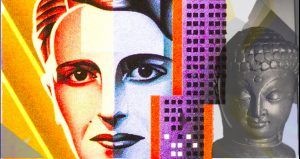“There are two sides to every issue: one side is right and the other is wrong, but the middle is always evil… In any compromise between food and poison, it is only death that can win. In any compromise between good and evil, it is only evil that can profit. In that transfusion of blood which drains the good to feed the evil, the compromise is the transmitting rubber tube.”
― Ayn Rand, Atlas Shrugged

Buddhism is one of the largest organized religions on the planet, based off of 2,500 years of history . By contemporary standards, it has over 700 million individual believers around the globe, making it the fourth largest religion. Although there are three main branches of Buddhist beliefs, they all respect the same principles: the Three Universal Seals (premise of existence), the Four Noble Truths (philosophical enlightenment), the 12 Links of Dependent Origination (laws of existence) and the Eight-Fold Path (guide to enlightenment). All of these principles stem from the “Middle Way”, which rejects extremes and finds the satisfactions of life from taking neither the “high” nor “low” road. The sixth-century Buddhist scholar Chih-I proposed this as a “third truth”, in which “there is a middle way between the extremes of indulgence and self-denial, free from sorrow and suffering. This is the way to peace and liberation in this very life” (Jack Kornfield).
I however, find all of this to be symptomatic of the “Cult of Moral Grayness” I defined in my piece, The Virtue of Selfishness. According to Buddhism, there is never a “black” or “white” answer, one cannot choose along the polarity lines. This denial of the reality is the problem. Buddhists believe, as I do, in fleshing out all the details prior to reaching to a conclusion, but they also believe in compromise, and area of “grayness”. What Buddhists seek is “not amorality, but something more profoundly irrational a nonabsolute, fluid, elastic, middle-of-the-road morality” (74).
Buddhism and I are at an impasse. However, I recently discovered Morgan Rosenberg’s new synthesized religion: Dark Buddhism . It is a fusion of Objectivism, meditation, and psychology. As an Objectivist, he also rejected some of Buddha’s tenants, mostly selflessness. By fusing the pacifism and respect of Zen Buddhism and the discipline of Objectivism, he realizes a “logically consistent whole” of personal principles to live by. As Rosenberg says in his manifesto, Dark Buddhism:
The most important aspect of the self in Dark Buddhism and even in the traditional Buddhist dharma is that your practice requires a conscious choice, and the consciousness is the key part of the self. You must make a conscious choice to step onto the path and you must exercise conscious decision-making and a conscious sense of self-responsibility to remain on the path.
Therefore, one can infer that the middle path in Dark Buddhism is no longer the middle. Buddhism opens your mind to the choices and the consciousness of the issues, but one eventually must make a choice that revolves around the self, another major pillar of Dark Buddhism. Rosenberg says that Buddhism can be interpreted by self-interest and choice, but the choices must be conscious and not fall into a “gray” area. For example, he says that the choices one makes on a daily basis “are not only discipline choices, such as whether to eat that Big Mac or not, but fundamental choices”. Buddhism, in Rosenberg’s eyes, and my own, is flawed, but can be fixed by making solid “black” or “white” selfish choices.
